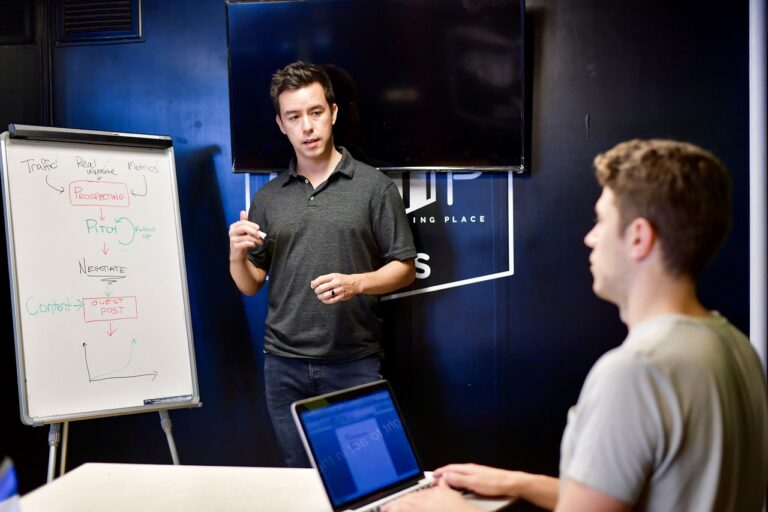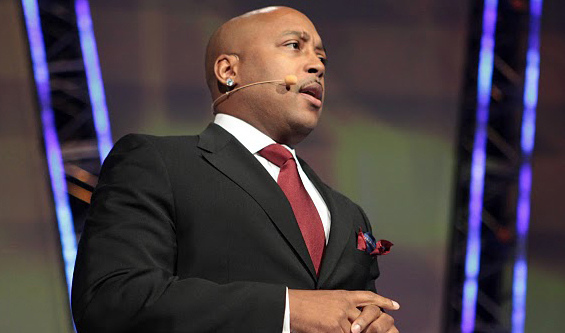The Transformative Power of Defining Who You Want to Be: A Shift in Leaders
Redefining Leadership: Discovering Your True Potential
In a fast-paced, goal-oriented world, it’s easy for leaders to become consumed by their ambitions and aspirations. Often, the focus is on what they want to achieve, rather than who they want to be. However, Bruce Van Horn, a renowned author and thought leader, suggests a different approach to leadership: “Spend more time thinking about who you want to be, rather than what you want to do.” This seemingly simple statement invites a deeper exploration into the nature of leadership and personal development. In this article, we will delve into the transformative power of shifting our mindset from a “what you want to do” mentality to a “who you want to be” perspective.
The traditional approach to leadership development has primarily revolved around setting and achieving specific goals, climbing the corporate ladder, and earning recognition for one’s accomplishments. While these pursuits can undoubtedly be fulfilling and lead to success, they may not be enough to create a truly lasting and impactful legacy. By concentrating solely on what we want to do, we may overlook the crucial aspect of who we want to become in the process.
The need for a shift in perspective becomes apparent when we consider the rapid changes in today’s world. With technological advancements, economic shifts, and increasing globalization, the nature of work and leadership is evolving at an unprecedented pace. To thrive in this environment, leaders must not only possess a diverse skill set but also embody the qualities that make them adaptable, resilient, and capable of inspiring others.
This article will delve into the importance of focusing on personal development in leadership and how it can contribute to a more sustainable and fulfilling leadership journey. We will examine the core elements of defining who you want to be as a leader, including vision, self-awareness, empathy, emotional intelligence, resilience, and adaptability. Practical steps for adopting a “who you want to be” mindset will be discussed, along with the benefits of this approach. Furthermore, we will explore real-world examples of successful leaders who have embraced this transformative shift in mindset.
As you read through this article, we invite you to reflect on your own leadership journey and consider the impact of focusing on who you want to be, rather than what you want to do. In doing so, you may discover a new level of personal and professional growth, one that transcends titles and accolades and contributes to a more meaningful, fulfilling legacy.
Section II: The Traditional Focus on “What You Want to Do”
The conventional approach to leadership often emphasizes the pursuit of tangible outcomes, accomplishments, and milestones. This section will explore the traditional focus on “what you want to do” and its potential limitations in fostering lasting, impactful leadership.
Emphasis on Goals and Accomplishments
In the pursuit of success, leaders frequently set their sights on specific goals and objectives. Whether it’s achieving a certain revenue target, completing a crucial project, or reaching a particular position within an organization, these milestones serve as markers of progress and accomplishment. While setting and achieving goals is undoubtedly essential for growth and development, a sole focus on these outcomes may lead to a narrow, short-term perspective on leadership.
Pursuit of Titles and Accolades
Another aspect of the traditional leadership mindset is the desire to attain prestigious titles and accolades. Climbing the corporate ladder, obtaining advanced degrees, and being recognized for one’s achievements can be highly motivating and validating. However, when leaders place an excessive emphasis on these external markers of success, they may inadvertently neglect the inner qualities and values that contribute to sustainable, purpose-driven leadership.
Limitations of This Approach
The traditional focus on “what you want to do” has some inherent limitations that may hinder long-term growth and fulfillment in leadership. These limitations include:
-
The risk of burnout: Pursuing relentless goal attainment and external validation can result in chronic stress, overwork, and eventual burnout. When leaders are consistently striving to achieve more without taking the time to reflect on their values, purpose, and well-being, they may find themselves depleted, disengaged, and unfulfilled.
-
The potential for moral compromise: When the pursuit of achievements becomes a primary driving force, leaders may be more inclined to prioritize short-term gains over ethical considerations. This focus on “what you want to do” can inadvertently lead to decisions and actions that undermine trust, integrity, and the long-term success of an organization.
-
A lack of adaptability: As the world continues to change rapidly, leaders who focus solely on specific goals and accomplishments may find it challenging to adapt to new circumstances, technologies, or markets. By neglecting the development of essential personal qualities and values, these leaders may struggle to pivot or innovate when faced with unforeseen challenges or opportunities.
-
Diminished personal fulfillment: While achieving goals and accumulating accolades can be rewarding, these markers of success may not provide lasting satisfaction or fulfillment. When leaders define their worth solely by their achievements, they may struggle to find a deeper sense of purpose and meaning in their work and personal lives.
In light of these limitations, it becomes clear that a more comprehensive approach to leadership development is needed—one that goes beyond the traditional focus on “what you want to do” and delves into the more profound, transformative question of “who you want to be.” In the following sections, we will explore this shift in perspective and its potential to foster more sustainable, meaningful, and fulfilling leadership.
Understanding the Importance of “Who You Want to Be”
In contrast to the traditional focus on “what you want to do,” embracing the concept of “who you want to be” offers a more holistic approach to leadership development. This section will explore the significance of shifting one’s perspective towards personal growth and the cultivation of essential leadership qualities.
Role of Values and Beliefs in Shaping Our Actions
Our values and beliefs serve as the foundation upon which we build our actions and decisions. They act as a compass, guiding us towards our goals while also providing a sense of purpose and direction. By focusing on “who you want to be,” leaders can develop a strong, values-driven foundation that informs their actions and decisions. This, in turn, fosters greater alignment between personal and professional aspirations, leading to a more consistent, authentic, and ethical leadership style.
Developing a Deeper Sense of Purpose
A fundamental aspect of the “who you want to be” mindset is the cultivation of a deeper sense of purpose. This involves reflecting on one’s passions, values, and long-term vision, as well as considering the broader impact of one’s work on the world. By developing a clearer understanding of their purpose, leaders can inspire and motivate others more effectively, as well as stay resilient and focused in the face of challenges and setbacks.
Cultivating a Growth Mindset
Embracing the concept of “who you want to be” also involves adopting a growth mindset—a belief in one’s ability to learn, grow, and improve over time. This mindset encourages leaders to view setbacks and failures as opportunities for growth, rather than as insurmountable obstacles. With a growth mindset, leaders can maintain their motivation and dedication to personal development, even when faced with difficulties or disappointments. Additionally, this mindset fosters a culture of continuous learning and improvement, both for the individual leader and for their organization as a whole.
By focusing on “who you want to be,” leaders can develop a more profound sense of self-awareness, purpose, and adaptability, which can lead to more sustainable and fulfilling leadership. In the following sections, we will explore the core elements of defining who you want to be as a leader, along with practical steps for adopting this transformative mindset.
Core Elements of Defining Who You Want to Be as a Leader
As we delve into the concept of “who you want to be,” it is essential to understand the core elements that contribute to this mindset. This section will explore four fundamental aspects of defining oneself as a leader: vision, self-awareness, empathy and emotional intelligence, and resilience and adaptability.
Vision
-
Creating a vivid picture of your ideal self: Developing a vision for who you want to be as a leader involves creating a clear and compelling picture of your ideal self. This image should encompass not only your professional aspirations but also your personal values, passions, and desired impact on the world. By articulating this vision, you can establish a strong sense of direction and purpose, which can guide your decisions, actions, and growth.
-
Aligning your personal and professional goals: As you refine your vision, it’s important to ensure that your personal and professional goals are aligned. This alignment helps create a sense of harmony and balance, as well as fosters a more authentic, values-driven leadership style. When your personal values and aspirations are in sync with your professional pursuits, you are more likely to stay motivated, engaged, and committed to your leadership journey.
Self-Awareness
-
Identifying strengths and weaknesses: Gaining a deep understanding of your strengths and weaknesses is crucial in defining who you want to be as a leader. By recognizing your unique capabilities and areas for improvement, you can develop targeted strategies for personal growth and make more informed decisions about how to allocate your time, energy, and resources.
-
Embracing vulnerability and authenticity: As you cultivate self-awareness, it’s essential to embrace vulnerability and authenticity. Acknowledging your imperfections and being open about your struggles can help you build trust, forge stronger connections with others, and create an environment where learning and growth are encouraged.
Empathy and Emotional Intelligence
-
Understanding and connecting with others: Empathy and emotional intelligence play a critical role in effective leadership. By developing a deep understanding of others’ emotions, needs, and perspectives, you can foster more meaningful connections, build stronger teams, and create a more inclusive, supportive work environment.
-
Developing compassionate leadership: Embracing empathy and emotional intelligence also involves cultivating compassionate leadership. This approach focuses on supporting the well-being and growth of others, as well as seeking to understand and alleviate the challenges they face. By adopting compassionate leadership, you can inspire loyalty, enhance collaboration, and foster a positive organizational culture.
Resilience and Adaptability
-
Overcoming setbacks and challenges: Resilience and adaptability are crucial qualities for leaders in today’s ever-changing world. By learning to bounce back from setbacks and challenges, you can maintain your motivation and commitment to growth, even in the face of adversity.
-
Continuous learning and improvement: Resilience and adaptability also involve embracing a mindset of continuous learning and improvement. This mindset encourages leaders to view change and uncertainty as opportunities for growth, rather than threats. By staying open to new ideas, experiences, and perspectives, you can foster innovation, drive organizational success, and become a more effective, adaptable leader.
By cultivating these core elements—vision, self-awareness, empathy and emotional intelligence, and resilience and adaptability—leaders can define who they want to be and embark on a more fulfilling, impactful leadership journey. In the following sections, we will discuss practical steps for embracing this mindset and explore the benefits of adopting a “who you want to be” approach to leadership.
Practical Steps to Focus on Who You Want to Be
Having explored the core elements of defining who you want to be as a leader, it is essential to discuss the practical steps that can facilitate this transformation. This section will provide actionable recommendations for embracing the “who you want to be” mindset and fostering personal growth.
Reflect on Your Values and Beliefs
Taking time to reflect on your values and beliefs is crucial in shaping your leadership identity. Set aside dedicated time to contemplate what truly matters to you, what drives your decisions, and how your values align with your actions. This self-reflection can lead to greater self-awareness and help you identify areas where adjustments may be needed to create more alignment between your values and leadership practices.
Engage in Regular Self-Assessment and Self-Improvement
Commit to regularly assessing your strengths, weaknesses, and growth areas. This practice can be done through journaling, self-reflection, or engaging in structured assessments like personality tests or 360-degree feedback. As you identify areas for improvement, set specific, attainable goals for personal growth and seek out resources, such as books, courses, or mentors, that can support your development.
Develop a Personal Mission Statement
Creating a personal mission statement can serve as a guiding compass for your leadership journey. This statement should encapsulate your values, passions, and long-term vision. By articulating your mission, you can maintain focus on who you want to be, even in the face of challenges or setbacks.
Seek Feedback and Support from Others
Actively seek feedback from colleagues, mentors, and trusted peers to gain valuable insights into your leadership style, strengths, and areas for improvement. Be open to receiving constructive criticism and use it to inform your personal growth. Additionally, consider joining or forming a support group of like-minded individuals who can offer encouragement, accountability, and guidance as you embark on your leadership journey.
Practice Mindfulness and Self-Compassion
Cultivating mindfulness and self-compassion is essential in fostering personal growth and developing a “who you want to be” mindset. Mindfulness practices, such as meditation or deep breathing exercises, can help you become more present, focused, and self-aware. Additionally, practicing self-compassion—treating yourself with kindness, understanding, and forgiveness—can help you navigate setbacks and challenges with grace and resilience.
By implementing these practical steps, leaders can more effectively focus on who they want to be and foster personal growth and development. In the following sections, we will discuss the benefits of adopting this approach and explore real-world examples of leaders who have embraced the “who you want to be” mindset.
Benefits of Adopting the “Who You Want to Be” Mindset
As leaders shift their focus from “what you want to do” to “who you want to be,” they can experience numerous benefits that enhance both their personal and professional lives. This section will explore the advantages of embracing this transformative mindset, including increased self-awareness, enhanced decision-making, and a more profound sense of fulfillment.
Increased Self-Awareness
One of the most significant benefits of adopting the “who you want to be” mindset is increased self-awareness. By focusing on personal growth and self-reflection, leaders can develop a deeper understanding of their values, strengths, and areas for improvement. This heightened self-awareness can lead to more authentic and values-driven leadership, as well as an increased ability to recognize and address personal and professional challenges.
Enhanced Decision-Making
With a greater focus on who they want to be, leaders are more likely to make decisions that align with their values and long-term vision. This alignment can result in more ethical, strategic, and impactful choices that contribute to sustainable organizational success. Additionally, leaders who prioritize personal development may be better equipped to navigate complex challenges, consider diverse perspectives, and make informed decisions under pressure.
Improved Relationships and Team Dynamics
Embracing the “who you want to be” mindset often involves cultivating empathy, emotional intelligence, and compassionate leadership. These qualities can help leaders build stronger connections with their team members, foster a more inclusive and supportive work environment, and enhance collaboration and trust. As a result, teams led by individuals who prioritize personal growth and self-awareness may be more cohesive, motivated, and high-performing.
Greater Resilience and Adaptability
By focusing on personal development, leaders can cultivate resilience and adaptability—two essential qualities in today’s ever-changing world. These traits enable leaders to bounce back from setbacks, adapt to new circumstances, and maintain their motivation and commitment to growth, even in the face of adversity. Furthermore, resilient and adaptable leaders are more likely to inspire these qualities in their team members, creating a more agile and innovative organizational culture.
Deeper Sense of Fulfillment
Finally, adopting the “who you want to be” mindset can lead to a more profound sense of fulfillment and satisfaction in one’s leadership journey. By prioritizing personal growth, aligning their actions with their values, and focusing on the broader impact of their work, leaders can experience a greater sense of meaning and purpose. This sense of fulfillment can contribute to increased motivation, engagement, and overall well-being.
By embracing the “who you want to be” mindset, leaders can experience numerous benefits that enhance their personal and professional lives. In the final section, we will explore real-world examples of successful leaders who have adopted this transformative approach to leadership.
Real-World Examples of Leaders Embracing the “Who You Want to Be” Mindset
To illustrate the impact and potential of the “who you want to be” mindset, this section will highlight real-world examples of successful leaders who have embraced this transformative approach to leadership. These examples demonstrate how focusing on personal growth, values, and long-term vision can lead to more effective, authentic, and fulfilling leadership.
Oprah Winfrey
Oprah Winfrey, the media mogul, talk show host, and philanthropist, is a prime example of a leader who has focused on who she wants to be. By staying true to her values and using her platform to uplift others, she has cultivated a leadership style that is compassionate, empathetic, and authentic. Oprah’s emphasis on personal growth, self-awareness, and continuous learning has enabled her to inspire millions and create a lasting, meaningful impact on the world.
Richard Branson
Sir Richard Branson, the founder of the Virgin Group, is known for his unconventional approach to leadership and his dedication to personal growth. Branson’s focus on values like innovation, risk-taking, and employee empowerment has shaped the culture of his companies and allowed him to continually evolve as a leader. By prioritizing personal development and staying open to new ideas, Branson has built a global empire and inspired countless entrepreneurs around the world.
Brene Brown
Dr. Brene Brown, a renowned researcher, author, and speaker, has dedicated her career to exploring the power of vulnerability, empathy, and authenticity in leadership. Brown’s work underscores the importance of self-awareness, emotional intelligence, and personal growth in cultivating effective leadership. By embracing the “who you want to be” mindset, she has empowered leaders to create more connected, supportive, and inclusive work environments.
Satya Nadella
Satya Nadella, the CEO of Microsoft, has been widely praised for his focus on empathy, collaboration, and personal growth in his leadership style. By prioritizing self-awareness and emotional intelligence, Nadella has fostered a more innovative, agile, and inclusive culture at Microsoft. Under his leadership, the company has experienced a significant transformation, both in terms of its market performance and its reputation as an employer. Nadella’s commitment to the “who you want to be” mindset serves as a powerful example of how focusing on personal growth and values can drive organizational success and create lasting change.
Jacinda Ardern
Jacinda Ardern, the Prime Minister of New Zealand, is another leader who exemplifies the “who you want to be” mindset. Known for her compassionate and empathetic leadership style, Ardern has consistently prioritized the well-being of her citizens and has been praised for her response to crises, such as the Christchurch mosque shootings and the COVID-19 pandemic. By staying true to her values and focusing on personal growth, Ardern has inspired trust, loyalty, and admiration from people around the world.
These real-world examples demonstrate the power and potential of embracing the “who you want to be” mindset in leadership. By prioritizing personal growth, self-awareness, and values-driven decision-making, these leaders have been able to cultivate more effective, authentic, and fulfilling leadership styles. As we conclude our exploration of the “who you want to be” approach, it is essential to remember that this transformative mindset is accessible to anyone willing to invest in their own development and growth. By focusing on who you want to be, rather than solely on what you want to do, you can embark on a more meaningful, impactful, and rewarding leadership journey.
Cultivating the “Who You Want to Be” Mindset in Your Organization
As we have explored the power of the “who you want to be” mindset for individual leaders, it is also essential to consider how this transformative approach can be cultivated within organizations. In this section, we will discuss strategies for fostering a culture of personal growth, self-awareness, and values-driven leadership across all levels of your organization.
Create a Culture of Learning and Development
-
Encourage continuous learning: Emphasize the importance of ongoing learning and professional development for all employees. Offer resources, such as training programs, workshops, and mentorship opportunities, to support employee growth and encourage a growth mindset.
-
Foster a feedback-rich environment: Create a culture where feedback is actively sought and openly shared. Encourage managers to provide regular, constructive feedback to their team members, and promote a culture of transparency, trust, and open communication.
Align Organizational Values and Goals
-
Define and communicate organizational values: Clearly articulate your organization’s core values and ensure that they are consistently communicated and reinforced. Encourage employees to align their personal values with those of the organization, fostering a sense of shared purpose and commitment.
-
Set values-driven goals: Establish organizational goals that are not only focused on performance outcomes but also on the development of desired leadership qualities, such as empathy, collaboration, and adaptability. This approach can help create a more holistic and values-driven approach to success.
Recognize and Reward Values-Driven Leadership
-
Celebrate authentic leadership: Encourage and recognize leaders who demonstrate a strong commitment to personal growth, self-awareness, and values-driven decision-making. Highlight their achievements and the impact of their leadership on the organization.
-
Implement values-based incentives: Develop performance metrics and incentives that reward employees for embodying desired leadership qualities, such as empathy, resilience, and adaptability. This approach can help reinforce the importance of focusing on who employees want to be, in addition to what they want to do.
Provide Opportunities for Self-Reflection and Growth
-
Encourage self-reflection: Create opportunities for employees to engage in self-reflection and personal growth, such as through journaling, mindfulness practices, or structured self-assessment exercises.
-
Offer coaching and mentorship: Provide coaching and mentorship programs that focus on personal growth, self-awareness, and values-driven leadership. Pair employees with experienced leaders or external coaches who can offer guidance, support, and insight on their personal development journey.
By cultivating the “who you want to be” mindset within your organization, you can create a more inclusive, collaborative, and innovative work environment that fosters personal growth, self-awareness, and values-driven leadership across all levels. By prioritizing personal development and aligning organizational values and goals, your organization can benefit from more authentic, resilient, and adaptable leaders who are better equipped to navigate the complex challenges of today’s ever-changing world.
Embracing Your Authentic Leadership Journey
As we reach the conclusion of our exploration into the “who you want to be” mindset in leadership, it is essential to revisit the key insights gained throughout this article and consider the lasting impact this transformative approach can have on both personal and professional success.
Power of Adopting a “Who You Want to Be” Mindset in Leadership
Throughout this article, we have seen how adopting a “who you want to be” mindset can lead to increased self-awareness, enhanced decision-making, improved relationships, greater resilience, and a deeper sense of fulfillment. By prioritizing personal growth, self-reflection, and values-driven decision-making, leaders can cultivate more effective, authentic, and rewarding leadership styles that have a meaningful impact on their teams and organizations.
Lasting Effects on Personal and Professional Success
The “who you want to be” mindset has the potential to create lasting positive effects on both personal and professional success. As leaders embrace this approach, they can experience not only improved performance and organizational outcomes, but also a more profound sense of purpose, satisfaction, and well-being. Furthermore, by fostering a culture of personal growth and self-awareness within their organizations, leaders can contribute to the development of more resilient, adaptable, and innovative teams that are better equipped to navigate the challenges of today’s ever-changing world.
Call to Embrace This Transformative Approach in Your Own Leadership Journey
As we conclude our exploration of the “who you want to be” mindset in leadership, we invite you to consider how you can incorporate this transformative approach into your own leadership journey. By focusing on who you want to be, rather than solely on what you want to do, you can embark on a more meaningful, impactful, and rewarding path that benefits not only yourself but also those around you.
In the words of Bruce Van Horn, “Spend more time thinking about who you want to be, rather than what you want to do.” By embracing this mindset, you can unlock your full potential as a leader, create lasting change, and leave a powerful legacy for generations to come.







